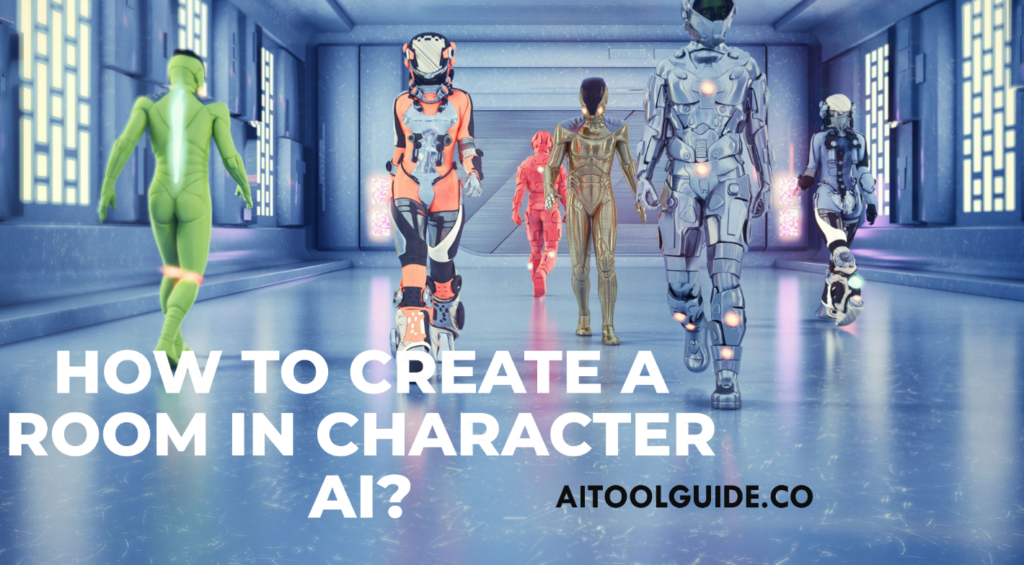We’re going through a revolution in online communication thanks to artificial intelligence (AI) chat rooms, and Character AI is leading the way.
Character AI is a cutting-edge web application that lets users converse with fictional and historical characters generated by artificial intelligence.
Former Google AI experts developed this innovative platform that creates human-like text responses, making interactions feel remarkably authentic.
The recently introduced Character Group Chat promotes creativity, learning, and social connection by enabling multiple AI characters, humans, and other characters to converse simultaneously.
Whether you’re looking to role-play with mythological gods, brainstorm with historical geniuses, or simply enjoy a lively chat with friends and AI, Character AI chatrooms offer endless possibilities for meaningful and entertaining interactions.
Types of Character AI Chatrooms
Character AI chatrooms offer a versatile and engaging platform for users to interact with AI-driven characters in various settings. Here are the primary types of chatrooms available:
Individual Chatrooms
Individual chatrooms facilitate one-on-one conversations between a user and an AI character. These interactions are designed to feel personal and immersive, allowing users to engage deeply with the character’s personality and responses.
Whether you’re chatting with a historical figure, a fictional character, or a custom-created persona, individual chatrooms provide a focused and intimate experience.
This setup is particularly beneficial for personalized learning, such as practicing a new language or exploring detailed historical narratives.
Group Chatrooms
Group chatrooms enable dynamic interactions between multiple AI characters and human participants.
In these settings, users can observe and participate in conversations where AI characters interact with each other, bringing diverse perspectives and conversation styles into the mix.
This can create a more lively and entertaining environment, perfect for role-playing scenarios, collaborative storytelling, or even educational debates.
Group chatrooms can be particularly useful for exploring complex topics or simulating real-world social interactions.
Public vs. Private Chatrooms
Character AI offers both public and private chatroom options, catering to different user needs for accessibility and privacy.
Public Chatrooms: These are open to all users, allowing anyone to join and participate in the conversation. Public chatrooms are ideal for community engagement, where users can share ideas and interact with a broader audience.
Private Chatrooms: These are restricted to invited participants only, ensuring a controlled and secure environment. Private chatrooms are suitable for sensitive discussions, private role-playing sessions, or any scenario where privacy is a priority. Users can also create unlisted chatrooms, which are not searchable but accessible via a direct link, offering a middle ground between public and private settings.
These different types of chatrooms in Character AI provide a flexible and rich platform for users to explore a wide range of interactions, from private, one-on-one conversations to dynamic group discussions.
How to Create a Character AI Chatroom?
Creating a Character AI chatroom is a straightforward process that allows you to engage with AI characters in a personalized and dynamic environment. Here’s a step-by-step guide to help you set up your own chatroom:
1. Navigating to the Chatroom Creation Page
Open the Website: Start by opening your web browser and navigating to the Character AI website. Ensure you are logged into your account to access the chatroom creation features.
Access the Create Option: Once logged in, locate the “Create” button, typically found on the left-hand side of the page. Click on it to proceed to the chatroom setup options.
2. Selecting Characters and Setting Up the Chatroom
Create a Room: In the menu that appears after clicking “Create,” select the “Create a Room” option.
Name Your Room: Enter a name for your chatroom in the provided text box. This name will help you identify the room later.
Add Characters: Click on the character selection box to add AI characters to your chatroom. You can choose from a wide array of pre-existing characters or search for specific ones by name. You can add multiple characters to enrich the conversation dynamics.
3. Customizing Chatroom Settings
1. Set the Room Topic: Optionally, you can define a topic for your chatroom. This helps set the tone and context for the interactions within the room.
2. Choose Privacy Settings: Decide whether your chatroom will be public, private, or unlisted:
Public Chatrooms: Open to all users, allowing anyone to join and participate.
Private Chatrooms: Restricted to invited participants only, ensuring a controlled environment.
Unlisted Chatrooms: Not searchable but accessible via a direct link, offering a balance between privacy and accessibility.
4. Create the Room
After filling in the necessary details, click on the “Create” button to finalize your chatroom setup. Your room is now ready for interaction, and you can start engaging with the selected AI characters.
Video Tutorial
For a visual guide, you can refer to comprehensive video tutorials available on YouTube. These videos provide step-by-step instructions and additional tips for creating and managing your Character AI chatroom. Here are a couple of recommended tutorials:
By following these steps, you can easily create a Character AI chatroom tailored to your preferences, whether for private conversations, group discussions, or public engagement.
Benefits of Using Character AI Chatrooms
Character AI chatrooms offer numerous benefits, making them a versatile tool for various applications.
For entertainment, these chatrooms provide users with the opportunity to engage in lively conversations with fictional and historical figures, allowing for an immersive experience that brings stories and personalities to life.
This feature is particularly appealing to fans of literature, movies, and history, as it offers a unique way to interact with beloved characters and explore different narratives.
From an educational perspective, Character AI chatrooms serve as a valuable resource for learning new languages and acquiring historical knowledge.
Users can practice language skills in a realistic setting or engage in discussions with AI characters that embody experts in diverse fields, enhancing their understanding and critical thinking abilities.
Creativity is another significant advantage, as users can develop and interact with user-created characters, fostering imaginative storytelling and role-playing scenarios.
This aspect encourages users to explore their creative potential and experiment with character development.
Lastly, Character AI chatrooms facilitate social interaction by providing a platform for sharing ideas and collaborating in group chats.
This feature supports community building and enhances communication skills, making it an excellent resource for personal and professional development.
Limitations and Challenges
Character AI chatrooms, while innovative, face several limitations and challenges. One major issue is the accuracy and responsiveness of AI-generated responses.
Users often encounter repetitive or irrelevant replies, which can diminish the quality of interactions and make conversations feel less engaging.
Another significant challenge is moderation and safety. Ensuring that content remains appropriate and interactions are safe is crucial.
Despite using proprietary tools to block violating content, these systems are not foolproof and require continuous improvement.
Additionally, scalability is a concern, as there are limits on the number of participants and characters that can join a chatroom, typically capped at 10 humans and 10 AI characters per group chat.
These constraints can hinder the user experience, especially in larger, more dynamic discussions.
Popular Uses of Character AI Chatrooms
Character AI chatrooms are being utilized in various innovative ways, enhancing both personal and community experiences.
One popular use is in role-playing games (RPGs), where users create immersive storytelling experiences.
By interacting with AI characters, players can explore vast, open-world scenarios, solve puzzles, and engage in dynamic narratives that adapt to their choices, making each adventure unique and engaging.
Fan communities also benefit significantly from Character AI chatrooms.
Enthusiasts of popular series and universes can interact with their favorite characters, discussing plotlines, exploring alternative story arcs, and even co-creating new content.
This interaction not only deepens their connection to the source material but also fosters a sense of community among fans.
Additionally, Character AI chatrooms serve as a valuable tool for personal development. Users can practice conversations and social skills in a safe, controlled environment.
This can be particularly beneficial for individuals looking to improve their communication abilities, overcome social anxiety, or prepare for real-world interactions.
User Experiences and Testimonials
Character AI chatrooms have garnered a mix of positive feedback and criticisms from users. Many users praise the platform for its ability to create engaging and immersive experiences.
Success stories often highlight how individuals use the chatrooms for creative storytelling, role-playing, and even personal development, such as practicing social skills and overcoming anxiety.
Users appreciate the variety of characters available and the platform’s potential for entertainment and educational purposes.
However, there are also common complaints and areas for improvement.
Users frequently report issues with the accuracy and responsiveness of AI-generated responses, noting that the bots sometimes provide repetitive or irrelevant replies.
Additionally, there are concerns about the platform’s moderation and safety, with some users feeling that the content filters are either too strict or not effective enough.
Scalability is another challenge, as the number of participants and characters per chatroom is limited, which can hinder larger group interactions.
These criticisms suggest that while Character AI chatrooms offer valuable experiences, there is room for enhancing the quality and reliability of the interactions.
Future of Character AI Chatrooms
The future of Character AI chatrooms promises exciting developments that will enhance user experience and functionality.
Upcoming features include improvements in memory, voice capabilities, and group chat functionalities, allowing for more natural and contextually accurate conversations.
Integration with other platforms is also on the horizon, potentially enabling cross-platform interactions that make it easier for users to engage with AI characters across different devices and applications.
Advancements in AI technology, such as improved natural language understanding and generation, are expected to make interactions more seamless and intuitive, further bridging the gap between human and machine communication.
These enhancements will ensure that Character AI chatrooms continue to evolve, offering richer, more engaging, and versatile user experiences.
Conclusion
Character AI chatrooms offer a wealth of benefits and potential, making them a versatile tool for various applications.
They provide engaging conversations with fictional and historical figures, enhancing entertainment and educational experiences.
Users can practice new languages, learn historical facts, and develop creativity by interacting with user-created characters.
Additionally, these chatrooms facilitate social interaction, allowing users to share ideas and collaborate in group settings. As AI technology continues to advance, the potential for more immersive and dynamic interactions will only grow.
Exploring and utilizing Character AI chatrooms can lead to enriching personal and professional development, making them a valuable resource for all users.
- Guide to Connect Claude AI with Google Sheets in 2024 - October 11, 2024
- What is DreamGF? Honest review by Expert - October 9, 2024
- How to Use Claude AI in 2024? - October 7, 2024






